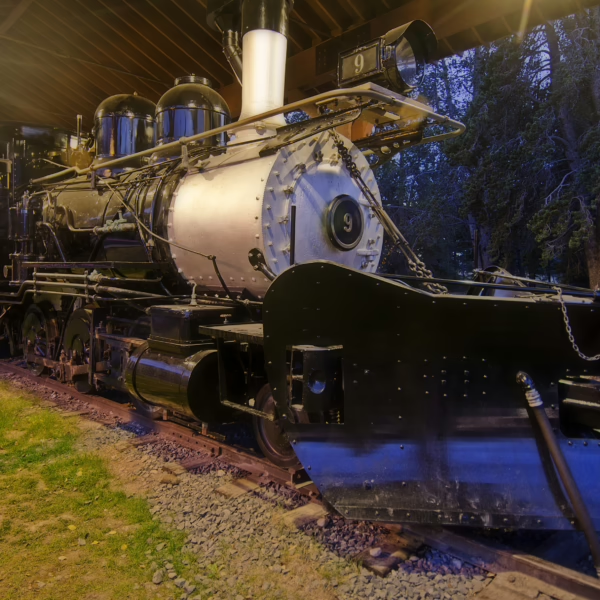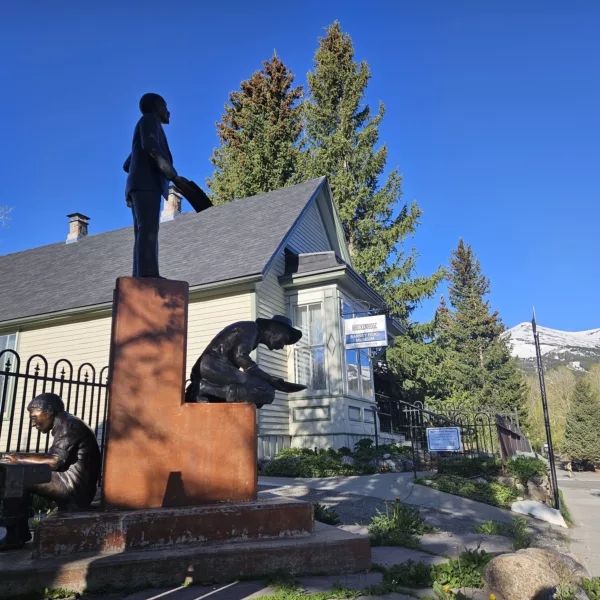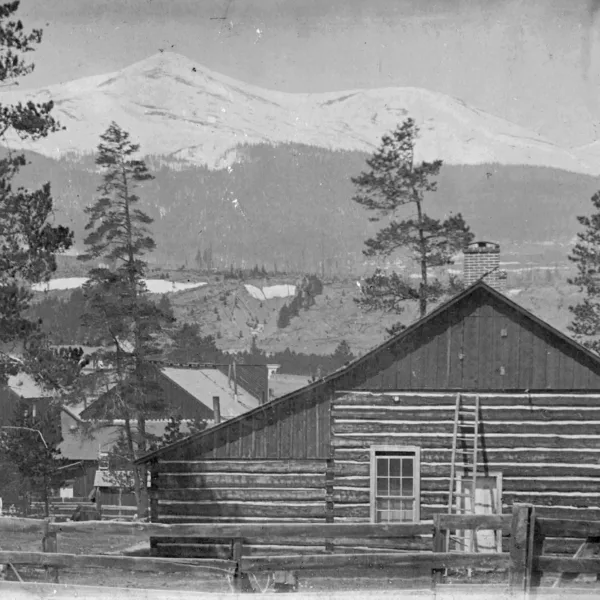Hacer historia: Una nueva exposición en Lomax
18 de junio de 2023 | Category: Hacer historia
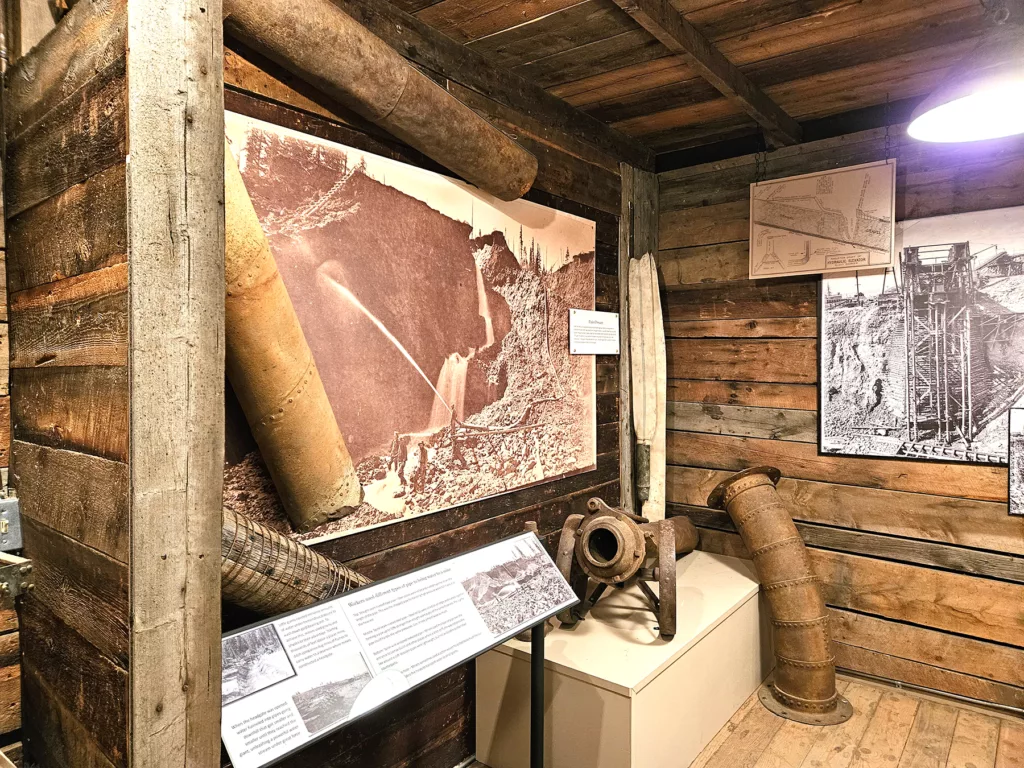
Índice
A LA TIERRA DEL ORO RELUCIENTE
JOHN YOUNG: BUSCADOR DE ORO, VIAJERO EN EL TIEMPO
EL MATERIAL DEL QUE ESTÁN HECHAS LAS EXPOSICIONES
Espero que se haya dado cuenta de que todos nuestros museos, yacimientos y visitas han estado cerrados durante el mes de mayo. Quizá se haya preguntado qué hacíamos los historiadores durante ese mes. Nos gusta pensar que estuvimos "Haciendo Historia".
El mundo que nos rodea, nuestro medio ambiente, nuestras noticias, nuestra política... son historia en construcción. Pero, ¿cómo preservamos nuestro mundo para que sea un recurso para la próxima generación? ¿Y cómo mostramos todas las complejidades de la vida a las que se enfrentaron nuestras generaciones anteriores? Estas preguntas son una lucha constante en el mundo de los museos y archivos, y son la razón por la que creamos el proyecto Hacer que la historia suceda en nuestro blog.
Por ejemplo, ha habido un cambio en el público en general desde la pandemia de COVID. Cada vez más gente quiere conocer el razonamiento y el proceso que hay detrás de lo que ve. Del mismo modo que una noticia gana credibilidad si incluye la información de origen adecuada, lo mismo ocurre con una exposición de museo, y si se puede echar un vistazo al proceso, mejor que mejor. Este es nuestro plan para la entrada de blog de este mes: Un vistazo al proceso de creación de nuestra exposición más reciente, es decir, lo que hemos estado haciendo durante el mes de mayo.
A LA TIERRA DEL ORO RELUCIENTE
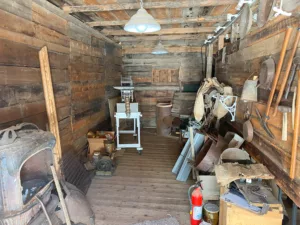
La exposición Land of Glittering Gold se encuentra en el Giger Barn de la Mina Lomax Placer (sólo se puede ver con reserva para buscar oro), pero vamos a contarle entre bastidores cómo se construyó esta exposición. Originalmente, este lugar fue comisariado hace años, pero nos dimos cuenta de que este edificio en particular no era tan atractivo como podría haber sido. Nuestro director ejecutivo, el archivero e innumerables miembros del personal pasaron el otoño pasado y esta primavera limpiando el lugar y decidiendo qué tenía más valor histórico. En el proceso aprendimos mucho sobre nosotros mismos y nuestro sitio: al parecer, nos gusta acaparar palas. También nos dimos cuenta de que teníamos un montón de material de gran valor a mano, que podría beneficiarse de una nueva presentación. Por último, aprendimos la importancia de tener un gran equipo de personas, como Scott Toepfer y Mike Zobbe, dispuestos a asumir algunos trabajos bastante salvajes - ya sabes, cosas como cerrar hasta la última grieta para evitar la infestación de roedores y limpiar 40 años de cosas de los áticos de los edificios.
 Nuestra limpieza incluyó varios viajes de recogida de basura y reciclaje, un encontronazo con un equipo de materiales peligrosos y mucho trabajo para hacer realidad la visión de este lugar. Esta es una de las partes de la historia más difíciles: no se puede conservar todo. En la escuela de archivística la llaman "la noche oscura del alma", cuando te quedas despierto preguntándote si deberías haber conservado esa pieza que has decidido retirar o tirar a la basura. Todos hemos perdido mucho sueño.
Nuestra limpieza incluyó varios viajes de recogida de basura y reciclaje, un encontronazo con un equipo de materiales peligrosos y mucho trabajo para hacer realidad la visión de este lugar. Esta es una de las partes de la historia más difíciles: no se puede conservar todo. En la escuela de archivística la llaman "la noche oscura del alma", cuando te quedas despierto preguntándote si deberías haber conservado esa pieza que has decidido retirar o tirar a la basura. Todos hemos perdido mucho sueño.
Algunos de nuestros artículos han tenido una nueva vida en otros lugares. La próxima vez que pases por aquí, saluda a nuestros fogones. Pizza de hojalata - algunos fueron a parar al almacén y otros encontraron una nueva vida con una reinterpretación en nuestra nueva exposición: ¿alguien quiere ver la maqueta de un barco draga? Después de todas las meticulosas elecciones, hemos reducido nuestros artefactos para poder presentarlos de una manera significativa para ayudar a hacer la historia entretenida y educativa para nuestros visitantes del museo.
JOHN YOUNG: BUSCADOR DE ORO, VIAJERO EN EL TIEMPO
Así que, una vez determinado el emplazamiento de la exposición y a medida que se iba embelleciendo el lugar, la pregunta que se planteó fue cómo hacer que esta exposición cobrara vida. La respuesta a esta pregunta llegó en forma de "John D. Young and the Colorado Gold Rush", un libro publicado por Lakeside Press que detalla el diario inédito de John D. Young.
Young era un exitoso hombre de negocios en Chicago cuando la fiebre del oro invadió el país y, como mucha gente, decidió abandonar la seguridad y la certidumbre de su hogar por las grandes posibilidades y la aventura de convertirse en buscador de oro. Partiendo de Chicago con otros seis viajeros, entre ellos uno de sus hermanos y su padre, Young atravesó el país en tren, barco de vapor, mula y, finalmente, a pie hasta llegar a Blue River Diggings, la actual Breckenridge. Ahora, Young ha atravesado casi 200 años para dar vida a la historia en La tierra del oro reluciente.
EL MATERIAL DEL QUE ESTÁN HECHAS LAS EXPOSICIONES
Una vez definida la historia, llegó el momento de decidir cómo se organizaría la exposición y qué fotografías, textos y objetos formarían parte de ella. Para ello, Kris Ann Knish, archivera de Breckenridge History, elaboró una maqueta de cómo sería la exposición y cómo fluiría. Hizo un trabajo increíble creando una visión coherente de la exposición, aunque dibujar a escala no sea su fuerte. Durante las dos semanas siguientes se hicieron más viajes a Lomax, con el metro en la mano, para ultimar todos los detalles.
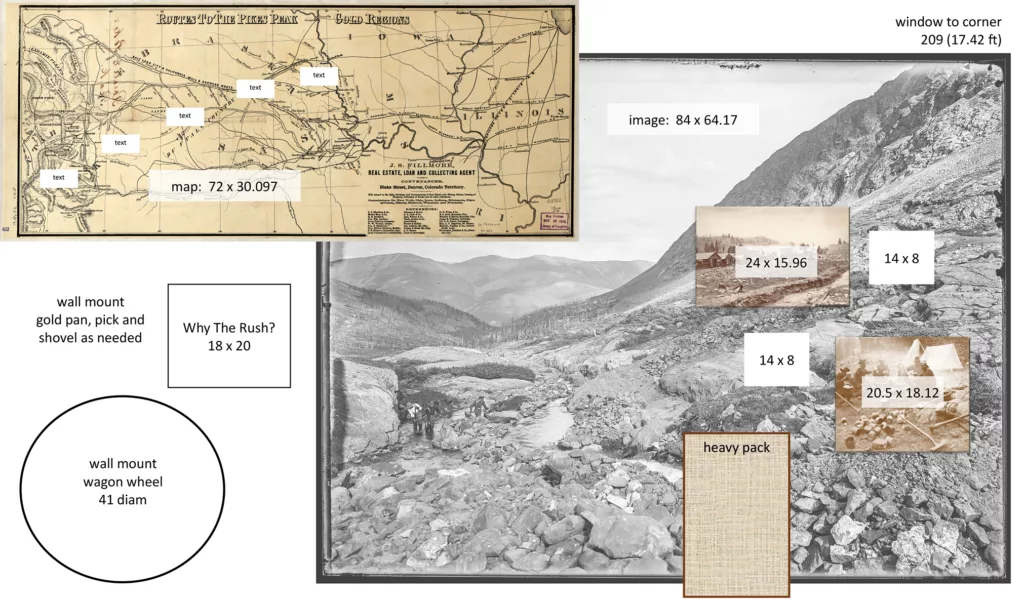
Uno de los grandes detalles que había que resolver era qué había que interpretar, dónde había que dejar que las palabras de Young hicieran la interpretación y qué objetos podían valer por sí mismos. El personal de la exposición pasó varios días extrayendo citas del diario de Young y elaborando paneles de texto para ayudar a los visitantes a entender lo que iban a ver en la exposición. Al mismo tiempo, también estuvimos trabajando en la preparación de nuestras fotografías históricas para su debut en la exposición. Este proceso implicaba tomar imágenes originales bastante pequeñas del siglo XIX y mejorarlas para poder exponerlas, ¡en un caso como un panel de 2,5 metros de ancho!
Una vez escrito todo el texto y ampliadas las fotografías, llegamos al último paso de esta parte del proceso: crear los títulos. Después de varios días encerrados en los archivos, es evidente que estábamos un poco nerviosos, así que disculpad todos los pitidos que veréis en los titulares, pero estábamos bajo presión.
LA CUENTA ATRÁS FINAL
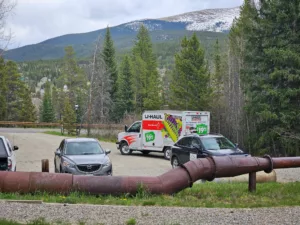 El tiempo que faltaba para la inauguración, el 1 de junio de 2023, se agotaba rápidamente y aún nos quedaba una gran duda: ¿Dónde se imprimen estos enormes paneles? Por suerte, habíamos trabajado con una empresa de Denver, Caña Schillersobre una exposición anterior en el Centro de bienvenida de Breckenridge y estaban dispuestos a ayudarnos de nuevo. Esto nos llevó a nuestra nueva y difícil pregunta: ¿Cómo se lleva un panel de 2,5 metros a Breckenridge desde Denver? A esta pregunta respondió nuestra intrépida líder, la Directora Ejecutiva Larissa O'Neil, y un U-Haul. O'Neil hizo el trayecto que a los demás nos daba miedo hacer y, con la ayuda de Schiller Reed, cargó todas nuestras fotografías ampliadas y paneles de texto en el U-Haul antes de regresar a la montaña el 30 de mayo.
El tiempo que faltaba para la inauguración, el 1 de junio de 2023, se agotaba rápidamente y aún nos quedaba una gran duda: ¿Dónde se imprimen estos enormes paneles? Por suerte, habíamos trabajado con una empresa de Denver, Caña Schillersobre una exposición anterior en el Centro de bienvenida de Breckenridge y estaban dispuestos a ayudarnos de nuevo. Esto nos llevó a nuestra nueva y difícil pregunta: ¿Cómo se lleva un panel de 2,5 metros a Breckenridge desde Denver? A esta pregunta respondió nuestra intrépida líder, la Directora Ejecutiva Larissa O'Neil, y un U-Haul. O'Neil hizo el trayecto que a los demás nos daba miedo hacer y, con la ayuda de Schiller Reed, cargó todas nuestras fotografías ampliadas y paneles de texto en el U-Haul antes de regresar a la montaña el 30 de mayo.
Los siguientes fueron nuestros gurús de la fabricación. Tim Johnson, que también había colaborado en una exposición anterior, creó bonitos soportes para algunos de nuestros objetos más interesantes, como un cubo de draga y una caja de globos, mientras que Breckenridge Ironworks Breckenridge Ironworks se las arregló para crear una armadura para una caja de balancines en un abrir y cerrar de ojos. Johnson, Toepfer, Zobbe y el personal de la exposición vivieron esencialmente en Lomax durante los dos días siguientes, en los que consiguieron colgar todas las fotografías, paneles de texto, herramientas y tuberías en las paredes del granero Giger, y en un par de lugares más por si aún no era un reto demasiado grande. ¿Hemos mencionado que también construyeron una estación de trituración de rocas? ¿Y que al mismo tiempo estábamos renovando el suelo y creando una nueva visita guiada para el Museo Barney Ford? ¿Y que llevamos a los estudiantes de excursión a Iowa Hill y al cementerio Valley Brook para el Día de los Caídos?
Con algunos retoques de última hora por parte de nuestro personal de Lomax, todos los edificios -incluso el baño recibió algunas mejoras- estuvieron listos para el debut del 1 de junio. Esperamos que en los próximos meses tenga la oportunidad de explorar Lomax y ver cómo hacemos que la historia suceda en ese lugar y en todos nuestros lugares de Breckenridge. Mientras tanto, pasaremos el próximo mes recuperándonos de nuestro perezoso mes de mayo.

